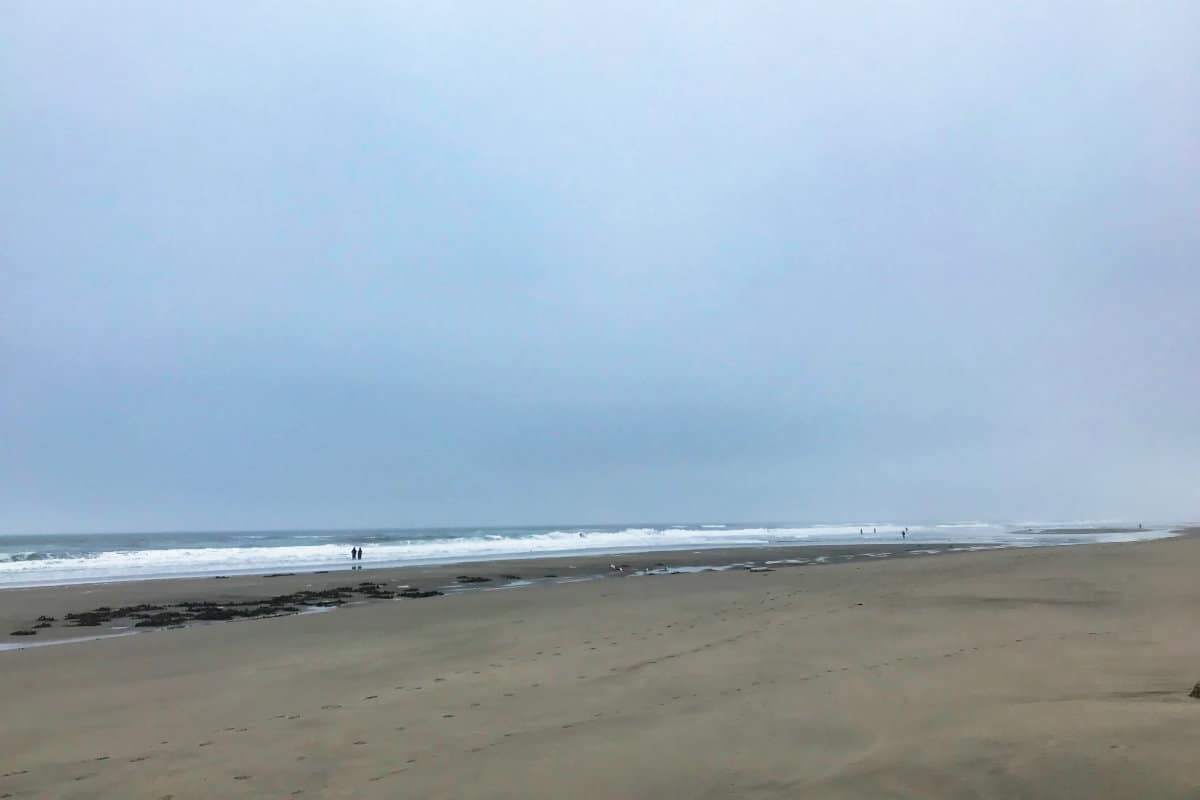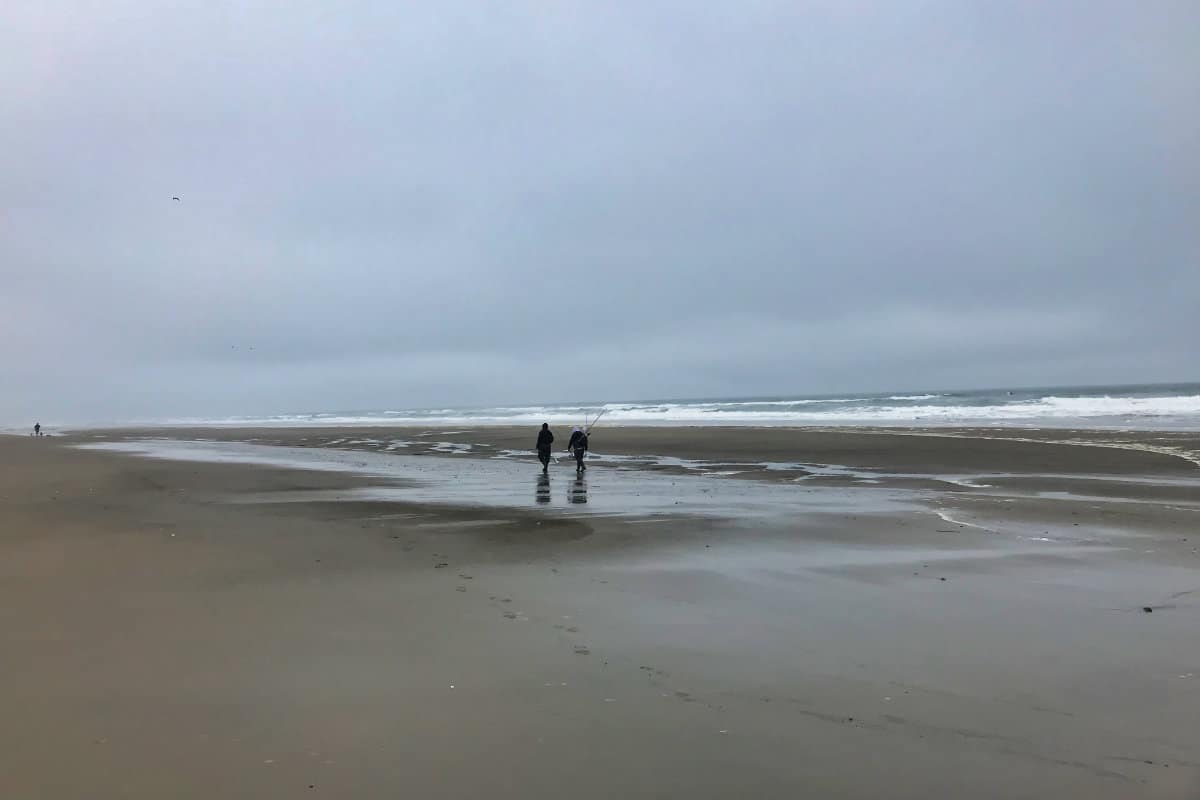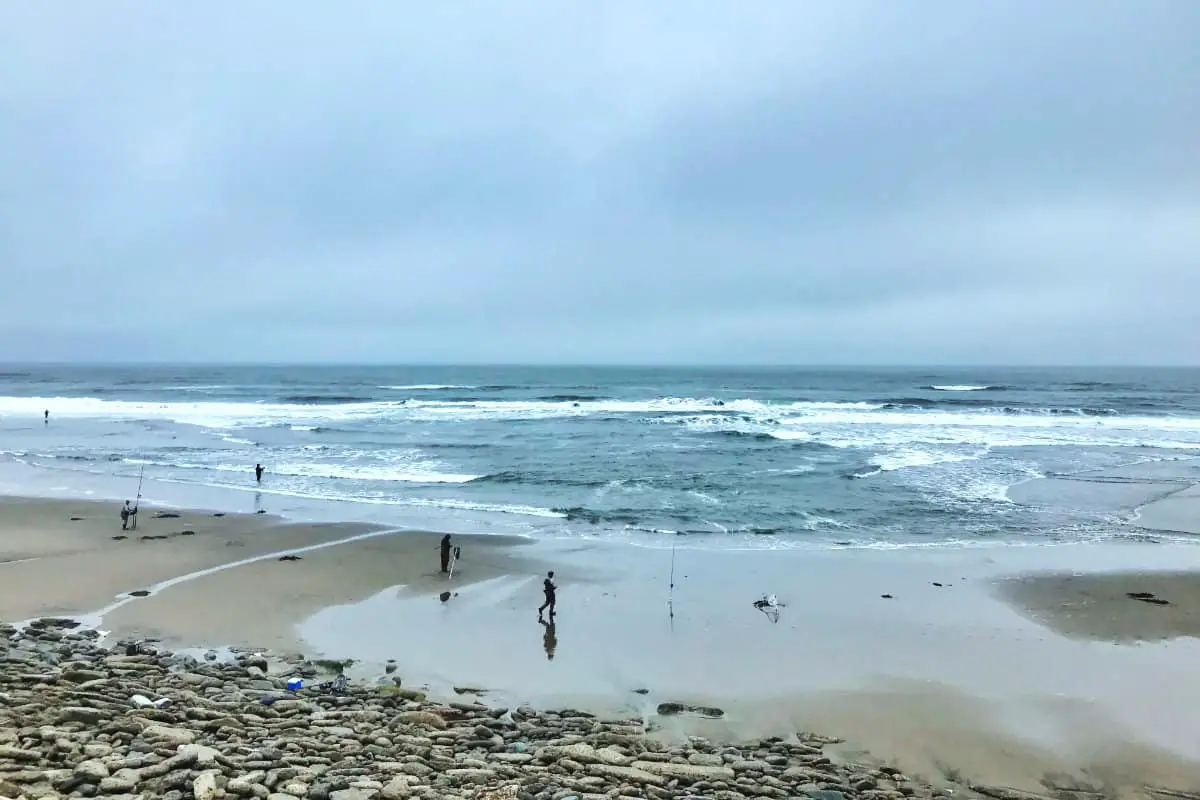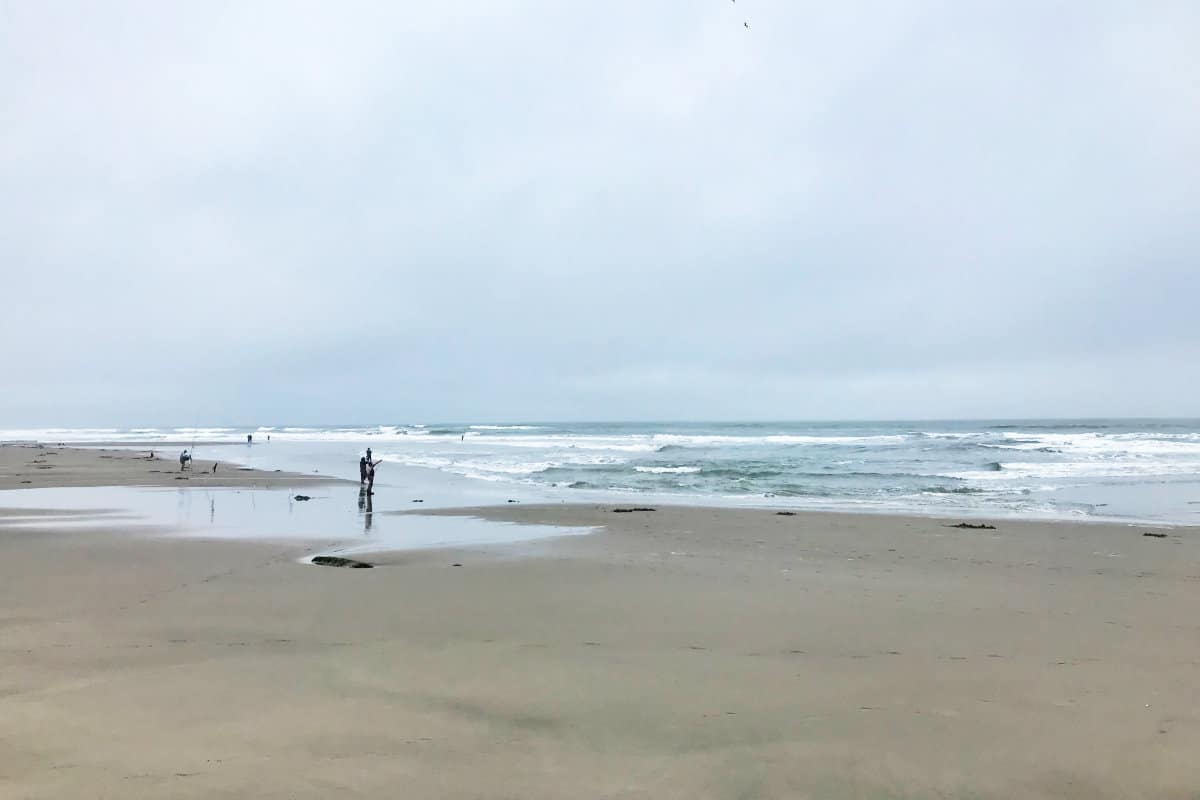Surf fishing is a fun, relaxing, and engaging hobby to take up if you love nature and enjoy being on the water. The best part is, you don’t need a boat! It’s easy to get started with this hobby. You just need the right gear and a good understanding of the body of water you are fishing in.
How do you surf fish when it’s low tide? To surf fish during low tide, you must understand the topography of the beach you are on and cast your rod far enough to reach fish in deeper water.
Discover some tips to get started with surf fishing, as well as some expert advice to surf fish on low tide.
Understanding the Basics of Surf Fishing
Surf fishing at low tide means that you will also need to be a solid surf fisherman, so before we go into the details of surf fishing on low tide, we’ll go over some of the basics.
Surf fishing is a fun sport in which you stand on the shoreline or wade in the surf of the ocean to catch fish. It often includes casting out bait, and it can include any type of shore from sandy or rocky beaches, rock jetties, or fishing piers.
Some fishermen believe that you are limited when you cast from dry land, but this is not always true. When surf fishing, you have access to deep-sea game fish and a wide variety of other fish you can find in shallow waters.
You can catch flounder, rockfish, mackerel, and more! It’s all about choosing the right conditions and equipment. Before you venture out, consider the location, weather and tide conditions, and season.
Surf fishing in low tide can be a challenging feat for beginners. That is why it is so important to learn the basics![]() of the sport before taking on low tides. Here are some of our best tips:
of the sport before taking on low tides. Here are some of our best tips:
Get Your Surf Cast Right
The first step in getting started with surf fishing is understanding how to surf cast. This type of fishing comes with an emphasis on distance and accuracy to land your cast in the right spot. To achieve this, use a basic overhand cast and practice learning the best speed and power you need.
Be One With the Beach
Next, learn how to read the beach. You need to be able to notice things about your location to find the sand bar where fish may be lurking. Look for locations where the waves begin to break as they come in.
It’s also a good idea to fish in areas where you see coarse sand and shells. These spots are more likely to be near deeper holes that can hold fish.
When in doubt, ask! If you are in a popular location for surf fishing, you may run into a local or beach regular who can point you in the right direction to find a good catch.
Pick the Ideal Weather Conditions
It may be surprising to learn that overcast and rainy days can actually be ideal for surf fishing. These weather conditions can minimize shadows from your lines. This, in turn, allows the fish to see and go for your bait a little more easily.
Gather Your Supplies
Now that you have a few tips to get started, it’s time to gather your materials. Here is some of the surf fishing gear you’ll need to get started:
● Saltwater fishing rod and reels
● Tackle and bait
● Surf fishing rigs
● Bait bucket
● Knife
● Sand Pike
● Sunscreen and sunglasses
● Fishing license
Some people prefer to hold their rod after they’ve cast it out. Others prefer a more relaxing experience and decide to anchor their rod in the sand while they wait. The choice is yours! Just make sure to purchase the proper materials to safely and securely anchor your equipment.
It’s also important to consider the type of fish you are looking for when you pick out your bait and tackle. Certain types of bait, whether it is live baitfish or invertebrates, can lure in different types of fish.
How Does Low Tide Affect Surf Fishing?

Moon phases and tidal movement![]() are often misunderstood; they are some of nature’s great mysteries. What we do know, however, is that these patterns have a great impact on how we are able to bait and catch fish.
are often misunderstood; they are some of nature’s great mysteries. What we do know, however, is that these patterns have a great impact on how we are able to bait and catch fish.
Just like choosing the best wind patterns for sailing, choosing to fish during certain tide patterns can greatly affect your surf fishing.
Before we discuss how to surf fish in low tide, we must first understand how tides work. Tides are the rising and falling of the sea level surrounding an ocean.
As the Moon revolves around Earth, and they each rotate around the Sun, they create gravitational forces. These forces cause the world’s oceans to rise and fall.
In most places around the world, two tidal cycles occur each day that cause ocean water to rise and fall on the shoreline. This coastline typography can have significant effects on local tides.
What Is the Best Tide for Surf Fishing?
Some say the optimal tide for surf fishing is a six-foot tidal swing. For example, starting in the morning at low tide of 0.2 feet and ending the afternoon with a high tide of 6.2 feet allows for the six-foot swing you’re looking for.
If tides are higher than this, they can create large upcoming and receding water movements, which can make it hard for the fish to see and catch your bait.
When the opposite happens, and the tide is low, there will be little water movement and less rotation of bait through your strike zone.
Depending on the beach you are on, and whether it has been dredged, various tide conditions can be more ideal. On natural, unaltered beaches, you can find success in both high and low tides. The topography of these beaches have not been changed, so they retain the structure that can work well for both tides.
Tides also affect the behavior of fish. More fish come in during high tide because there is more water available in your fishing hole. Certain species prefer low tide, however. During low tide, you can learn to read the beach and discover sandbanks, dips, hollow areas, and other important structures that will help you find fish.
Here are tips for catching specific types of fish while surf fishing:
● Corbin and Spotfin: Look for these fish during the incoming tide. Each wave tends to move them farther up the beach, over the sand and crab beds that were previously dry.
● Surfperch: Try to catch these fish when the high tide moves into a low tide. The receding waves help pull the bait into the offshore trough where the fish are.
● Halibut: Fish for this catch during peak high and low peak tide. They often feed during these times, staying low and buried in the sand waiting to strike their prey.
Learning How to Surf Fish with Low Tide

Surf fishing is a fun and popular hobby that many people love. However, it does come with a learning curve. As you have to understand the anatomy of shoreline, as well as the tide patterns in your area.
These all affect the conditions of the water and where the fish will be. If there’s any lack of knowledge in this area, beginning fishermen can come back home with empty hands and a defeated feeling.
Each angler has his or her own preferences when it comes to the tide patterns they prefer to work with while surf fishing. Some prefer to fish with the incoming tide, while others like the two hours on either side of the tide swing.
Even still, some people just like to fish when the water is moving. It is completely up to you to develop a feel for the water and its fish. The best way to learn and discover what works for you and your equipment is to practice!
Here are some types of tide you may experience:
● Floodtide: high tide, when water moves towards the land
● Ebbtide: low tide, when the waterfalls and moves back to the ocean
● Slack tide: the tide is not moving either way
Here are some steps to help you learn how to surf fish during low tide:
Get the Right Equipment
One of the first steps of any type of fishing is to make sure you have the ideal equipment. Your rig must be aerodynamic so that it can reach far distances when cast.
You can purchase a specialized shore rig that comes with a lead weight on end and one or more hooks that are attached to a snood above the weight. These come in different varieties like flapper rigs, clipped rigs, wishbone rigs, and pulley rigs.
If you want to surf fish more leisurely and let your rod sit without you holding it, you will need to build a strong surf fishing setup. Use spikes and rod holders so you can secure your rod on the beach when you are not holding onto it.
Avoid using options that aren’t as sturdy, like putting your rod in a bucket. These methods run the risk of your rod being pulled out to sea by a large fish. These rods are an investment, so you want to avoid damage to it.
Use the Best Bait and Keep It Cold
Each type of fish prefers a different kind of bait. Do your research or get advice from local fishermen to find out what bait works best for your area. Surf fishing favorites include clams, sand fleas, shrimp, squid, mullet, and cut bait. It’s also ideal to keep your bait alive and cold. You want it to look natural in the water or on the seabed to help attract more fish.
Use an aerated cooler to keep your bait at the right temperature. Then, make sure to securely mount the bait while maintaining that your hooks are unobtrusive. They should be able to take a good hold of a fish’s mouth.
Venture out Further in the Water
When low tide occurs, there is less water on the shore, and often, fewer fish to catch. To remedy this, you can go further out into the water. Cast your rod out further to reach the fish that are farther away.
Please note that you should always be cautious when standing on the shore and in deeper waters. Watch out for large waves and undertows that can be dangerous if you are not careful.
If you are wearing waders, make sure also to wear a wader belt to avoid water from filling up if you slip under the water. Also, make a note of the times tides change in your area. This way, you will know when it is best to move back closer to the shore.
Choose a Flat Beach
If you must fish during low tide, find a flat beach to fish on. In some flat, unaltered beaches, low tide conditions can actually be advantageous for fishermen. Your catch will all depend on what the bottom of the ocean is like.
Use a Shock Leader
It is often recommended to weigh down your bait into the water; this can help it reach fish that are below the surface. However, if you aren’t careful with this weight, you can experience crack off, or damaging your rod. Using a shock leader can help you prevent crack off. A shock leader is a strong piece of line that cushions the pressure of weighted casts.
Avoid Overcasting Your Rod
Many times, beginners believe that surf fishing is all about seeing who can cast their rod the furthest. However, this can pose issues during your fishing time. You do not want to throw your cast as far as your line allows.
If you do, you can lose control over your line and have less accuracy than when you carefully plan out your cast. Instead, aim for areas that are more likely to have fish, rather than trying to see just how far you can throw.
Protect Your Skin and Eyes from the Sun
One of the many methods of having a good surf fishing day is to, well, stay out all day. Many fishermen plan a six-hour-long day on the shore for surf fishing. They use this time to study the shore and pick the best location to cast their rod. This time allows them to experience a full cycle of tides, and in turn, get the best catch of the day.
However, staying out all day like this can make you exhausted, and it can expose you to a lot of the sun’s harmful rays. Make sure to wear protective sunscreen, sunglasses, a hat, and other clothing that will protect your skin and eyes.
Use Low Tide to Your Advantage

If you aren’t having any luck catching fish during low tide![]() , don’t worry! You can still be productive during this time. If you plan on fishing on a certain beach regularly, low tide is the perfect opportunity to take your time to study the beach.
, don’t worry! You can still be productive during this time. If you plan on fishing on a certain beach regularly, low tide is the perfect opportunity to take your time to study the beach.
Make a note of structural areas of the beach like gullies, hollows, banks, and more. Take pictures or create drawings to help you remember.
Consider questions like these:
● Does the seabed change in certain places?
● Are there any noticeable shellfish beds?
● Do you notice rough patches of weeds or rough ground?
Take note of the scene you’re experiencing. Then, you can remember the best spots to come back to when the tide is higher.
Study Tides Tables to Learn about Your Beach
Lastly, you can get a lot of benefit from tracking and studying tide tables. Start by marking where high waterfalls in the morning and the evening. Then, identify periods of spring tides. These occur when the sun, moon, and earth align, creating the largest tides on earth. They usually occur a day or two after a full moon.
Remember, there’s never a “perfect” time to surf fish in any spot you choose. Even locations that you have meticulously studied and charted will change occasionally. When you’re first learning how to surf fish, it’s best to go with the flow and study best practices for various conditions.
For many, the joy is in the journey and connecting with nature. With fishing, it’s important to understand that some days will just be more lucrative than others. The learning process is often the most fun for some fishermen, and it should be for you, too!
When Is Your Next Fishing Trip?
Surf fishing can be a fun, exhilarating hobby once you get the hang of it. There are many techniques and tricks that experienced fishermen use to get the most out of their time fishing.
When you’re first getting started surf fishing, the best thing you can do is practice, visit the beach at various hours each time you fish, and learn your shoreline!
Keep reading informational articles like this one to learn more about this exciting sport. Then, once you feel comfortable and ready to fish, get out there on the water and see what you can find!

